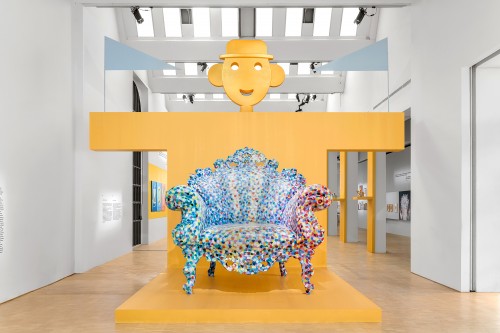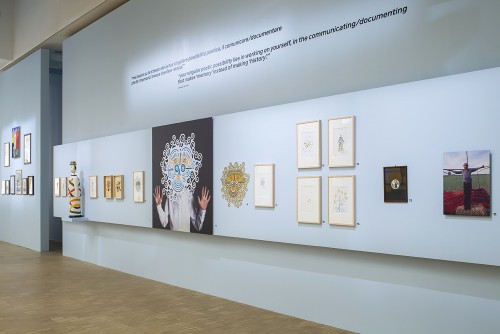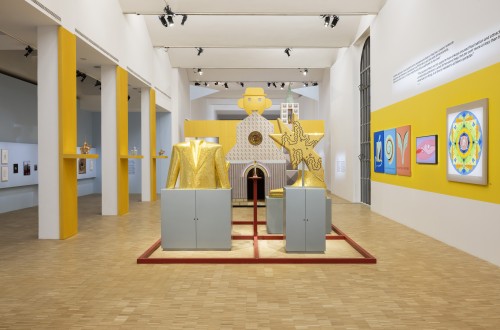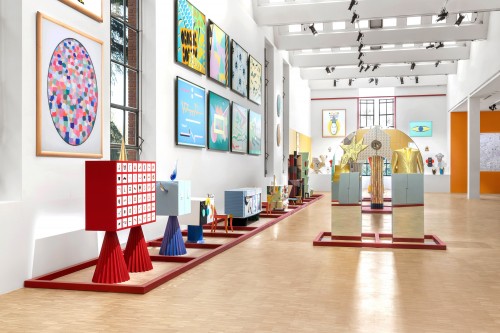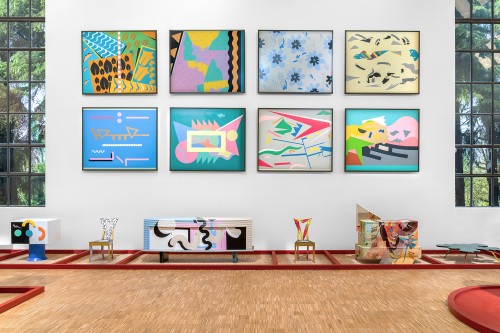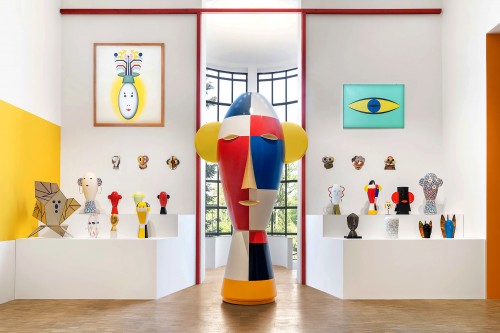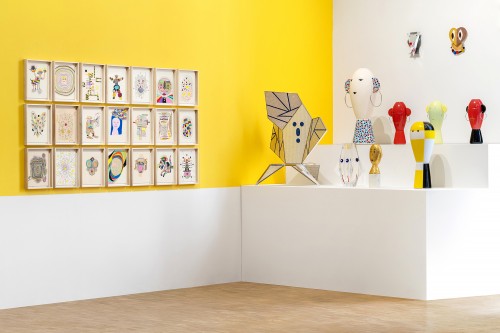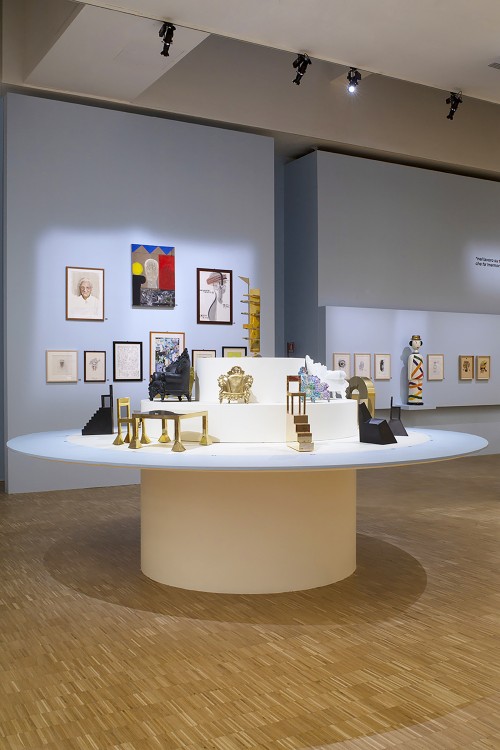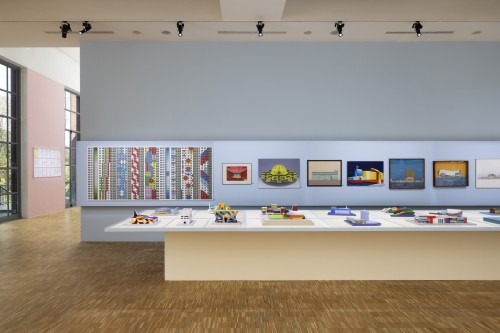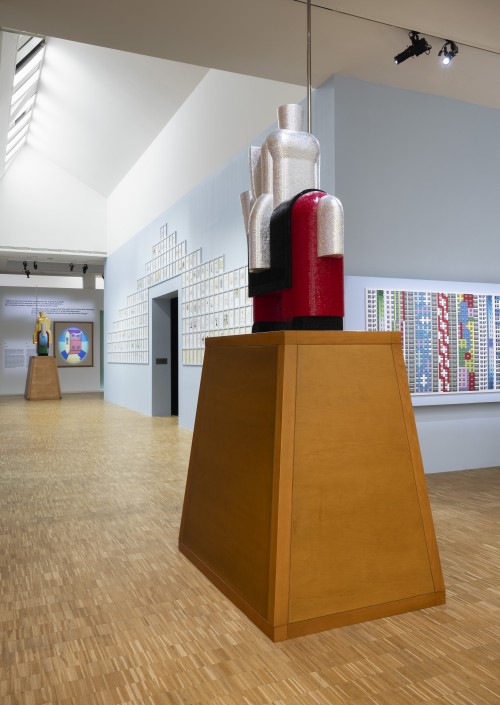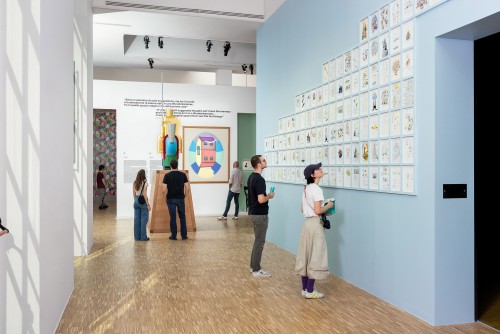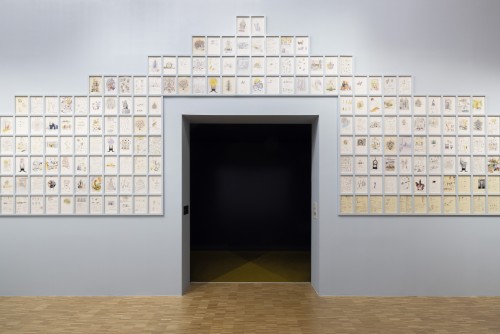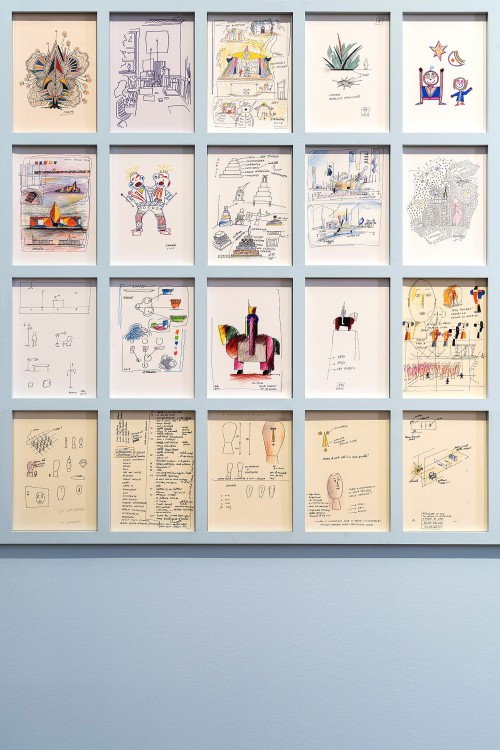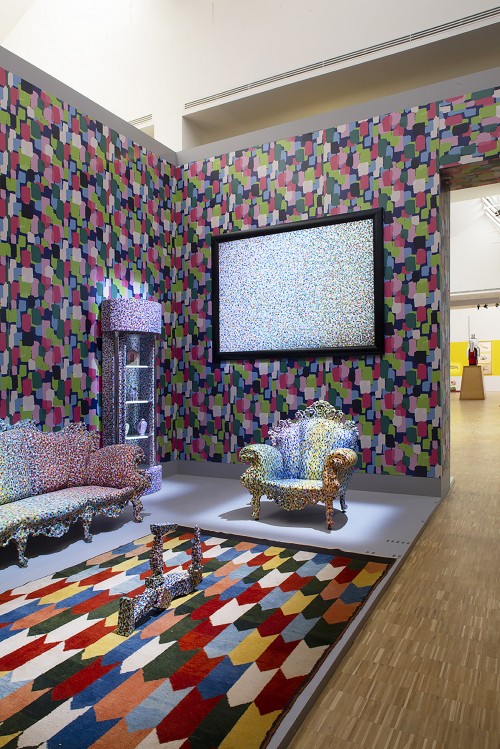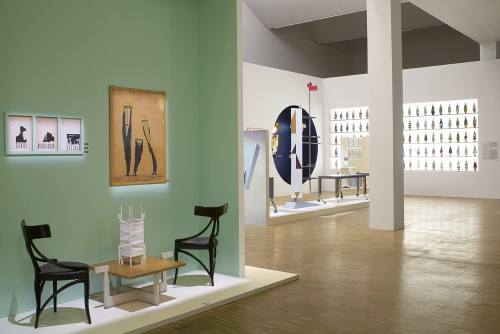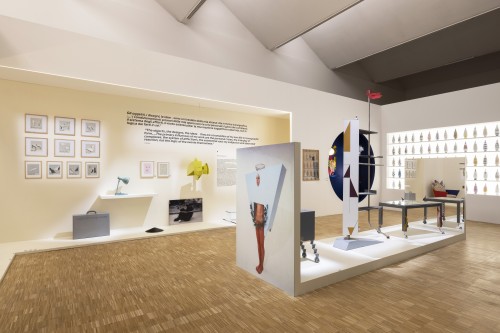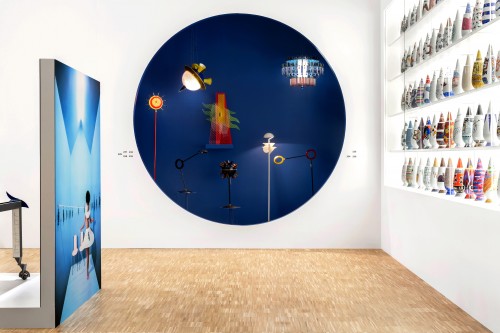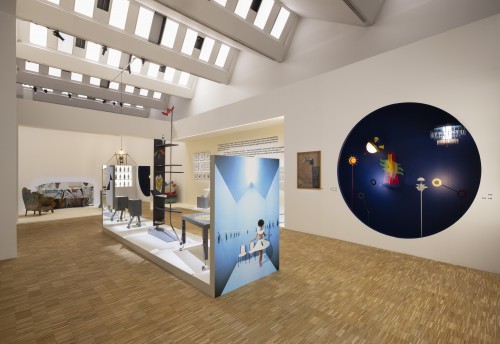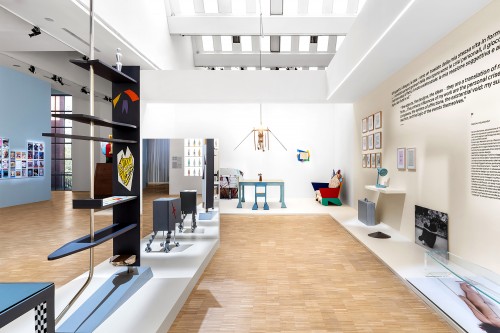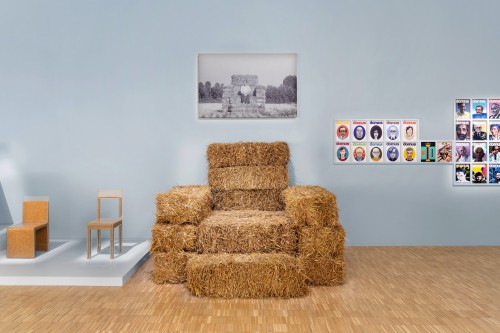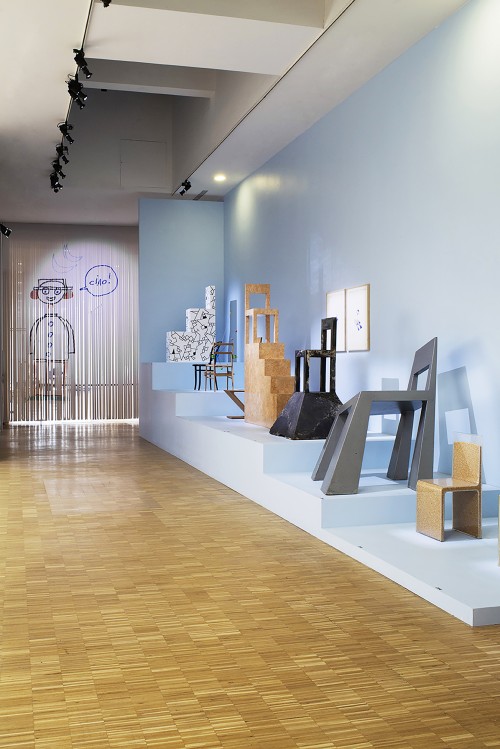PIERRE CHARPIN
ALESSANDRO MENDINI, IO SONO UN DRAGO
As I write these lines today in preparation for my contribution to the catalog for the exhibition Io sono un drago, just 20 years ago, at the beginning of January 2010, I received a call from Alessandro asking if I would be interested in and available to design the scenography for the third version of the Triennale Design Museum, which he was curating. Honored, I accepted the project, which very quickly presented itself as a challenge, given the short time available for its design and realization—just over two and a half months—and the scale and singularity of the proposal: more
than six hundred objects from a wide variety of origins, periods, sizes and types, from a ring to a
car, not forgetting a life-size plaster reproduction of Michelangelo’s David, to be brought into the museum space, and to give a spatial and legible form to Alessandro’s proposal. This third version, Quali cose siamo, made a distinct impression on me and, to this day, remains one of the most intense project experiences I’ve ever had.
In February last year, the Kreo gallery wanted to pay loving tribute to Alessandro with a small exhibition, and asked me if I would be involved in putting the exhibition together and writing a text for the occasion. I wrote the following by way of an introduction: “Caro Alessandro, I hereby adopt the form of address you yourself used for your letters in the magazine Domus, which you edited in the early 1980s, to some of your friends, at least in thought, architects, designers, artists, critics, publishers and readers. As you know, I’m not a specialist on Alessandro Mendini, not even one of your disciples (if there are any), nor a ‘Mendinian’ designer (if there are any), even though your thinking and some of your actions have had an undeniable influence on my approach to a project. So I can only express myself here from my personal point of view…’’
Here I am again, asked to design a major exhibition that Triennale Milano and Fondation Cartier pour l’art contemporain have jointly decided to devote to you, five years after your passing. One wonders whether all this might not contradict what I’ve just said. Be that as it may, it is once again a pleasure to be able to rub shoulders with, or rather to delve into your innermost thoughts and your abundant and multiform output. It goes without saying that the situation is very different from that of 2010. Now your presence is manifesting itself, beyond the memories we all carry within us, through your work, and it is this work that we, all of us involved in this exhibition project, must curate to offer it to the gaze (including our own) and appreciation of those who come to visit it.
So how do you find the right position in this stimulating exercise, which is also fraught with the delicate responsibility of designing a scenography for your now-completed work? Our aesthetics appear to be quite different. To put it simply, my general tendency is to lean towards less, operating more by subtraction, or let’s say towards re-strained expression (although I don’t consider this to be a dogmatic and fixed position), whereas yours clearly tended towards more, towards eclecticism and an expression that functioned by addition. It’s in the space created by this distance, however, that the point of our convergence lies (first and foremost our artistic approach to the project) and it’s from this point that I must work.
Being present through simple devices and spatial arrangements, such as the long axis that evokes, in the vast first exhibition hall, a street with its monuments in a line and its small “buildings” arranged on either side. Or in the second room, partitioned spaces that clearly evoke the configuration and intimacy of our living spaces as you imagined and represented them when you were creating the scenography, because you were so fond of them; Wunderkammer or stanze as you called them.
All of this amounts to designing and offering a path, an invitation to wander through your abundant, multidisciplinary work.
So, if, as the little self-portrait that inspired the title of the exhibition suggests, you are the dragon, this time it’s my turn to wield the sword, not that of Saint George, nor that of Dürer’s knight (very much present in the exhibition), but that of the designer-scenographer, in the shape of a “highlighter pen” to order, frame, underline, to guide and let express by itself the strength and variety of your multiform and colorful creations, as much decorative as theoretical… There’s nothing neutral, conventional or consensual about your work, but isn’t that what dragons are all about?
And let us hope that each and every one of us will be able to appreciate and gauge the scope and singular imprint that you have left on the great history of the project, and that all of this will restore to us, for a time, the acuity of your thinking, your irony, your irrepressible need to express yourself (outside of disciplinary frameworks and hierarchies of scales), on which you based your intense and passionate practice of the project which was none other than your very life itself.
Pierre Charpin, January 2024
PIERRE CHARPIN
ALESSANDRO MENDINI, IO SONO UN DRAGO
Alors que j’écris aujourd’hui ces lignes en vue de ma contribution au catalogue de l’exposition « Io sono un drago », il y a tout juste 14 ans, je recevais au début du mois de janvier 2010 un appel d’Alessandro qui me demandait si j’étais intéressé et disponible pour concevoir le projet de scénographie de la troisième version du Design Museum de la Triennale dont il était le commissaire. Honoré, j’acceptais le projet qui se présentait très vite comme un défi, du fait du peu de temps qui était imparti pour sa conception et sa réalisation, à peine plus de deux mois et demi, et par l’ampleur et la singularité de sa proposition : plus de six cents objets de provenances, d’époques, de tailles et de natures très diverses, de la bague à la voiture en passant par une reproduction en plâtre grandeur nature du David de Michelangelo, à faire entrer dans l’espace du musée, et donner une forme spatiale et lisible au propos d’Alessandro. Cette troisième version, ‘’Quali cose siamo’’, a fortement marqué les esprits et reste à ce jour l’une des expériences les plus intenses de projets qu’il m’ait été données de réaliser.
Au mois de février de l’année dernière, la galerie Kreo qui souhaitait rendre dans ses murs, au travers d’une petite exposition, un hommage affectueux à Alessandro, me demandait si je pouvais m’impliquer dans la mise en forme de l’exposition, et écrire un texte à cette occasion. J’écrivais ceci en guise d’introduction : ‘’ Caro Alessandro, je fais ici mienne la manière dont tu t’adressais, sous forme de lettre, dans la revue Domus que tu dirigeais au début des années 1980, à certain·e·s de tes ami·e·s, du moins en pensée, architectes, designers, artistes, critiques, éditeurs, lecteurs. Je ne suis pas, comme tu le sais, un spécialiste d’Alessandro Mendini, pas même un de tes disciples (s’il y en a), pas plus qu’un designer « Mendinien » (s’il y en a) même si ta pensée et certaines de tes actions ont eu une influence incontestable sur mon approche du projet. Je ne peux donc m’exprimer ici qu’à partir de mon point de vue personnel…’’
Voilà que je me retrouve de nouveau sollicité pour scénographier la grande exposition que la Triennale et La Fondation Cartier ont conjointement décidé de te consacrer, cinq années après ta disparition. C’est à se demander si tout ceci ne vient pas contredire le propos que je viens à peine de citer. Quoi qu’il en soit, c’est de nouveau un plaisir que de pouvoir côtoyer, je devrais plutôt dire entrer dans l’intimité de ta pensée et de ta production foisonnante et multiforme. Il va sans dire que la situation est bien différente de celle de 2010. Maintenant, ta présence se manifeste, au-delà des souvenirs que chacun porte en soi, au travers de ton œuvre, et c’est cette œuvre que nous devons, tous autant que nous sommes impliqués dans ce projet d’exposition, mettre en forme pour l’offrir au regard (dont le nôtre) et à l’appréciation de qui viendra la visiter.
Alors comment trouver la juste position dans cet exercice stimulant mais aussi chargé de la délicate responsabilité que de scénographier ton œuvre désormais achevée. Nos esthétiques sont d’apparences éloignées. Pour le dire simplement, ma tendance générale est de tendre vers le moins, en opérant davantage par soustraction, ou disons vers une expression retenue (bien que je ne tienne pas cela pour une position dogmatique et figée), alors que la tienne allait clairement vers le plus, l’éclectisme et une expression qui fonctionnait par addition. C’est pourtant dans l’espace créé par cette distance, que se trouve le point de notre rencontre, (en premier lieu notre approche artistique du projet) et c’est à partir de ce point qu’il me faut travailler.
Être présent par des dispositifs et une mise en espace simples, comme le grand axe dans le sens de la longueur qui évoque, dans la vaste première salle d’exposition, une rue avec ses monuments alignés et ses petits ‘’édifices’’ disposés de part et d’autre. Ou dans la seconde salle, des espaces cette fois ci cloisonnés qui renvoient clairement à la configuration et à l’intimité de nos lieux d’habitations tels que tu pouvais les imaginer et les représenter lorsque tu concevais, parce que tu les affectionnais, des ‘’wunderkammer’’ ou ‘’stanze’’ comme tu les nommais.
Tout cela revient à dessiner et offrir une circulation, une invitation à déambuler à l’intérieur de ton œuvre abondante et pluridisciplinaire.
Alors, si comme le suggère le petit autoportrait qui a inspiré le titre de l’exposition, tu es le dragon, à moi cette fois-ci de tenir la lance, non pas celle de Saint Georges, pas plus que celle du chevalier de Durer (bien présent dans l’exposition), mais celle du designer-scénographe, en forme de ‘’stylo surligneur’’ pour ordonner, cadrer, souligner, pour accompagner et laisser s’exprimer par elle-même la force et la variété de ta production multiforme et colorée, autant décorative que théorique… œuvre qui n’a rien de neutre, de convenu ni de consensuel, mais n’est-ce pas cela le propre du dragon ?
Et gageons que chacune et chacun pourra apprécier et mesurer l’ampleur et l’emprunte singulière que tu laisses dans la grande histoire du projet, et que tout cela puisse nous restituer pour un temps, l’acuité de ta pensé, ton ironie, ton irrépressible besoin de t’exprimer (hors des cadres disciplinaires et des hiérarchies d’échelles), sur lequel tu as fondé ta pratique intense et passionnée du projet qui n’était autre que ta vie même.
Pierre Charpin, Janvier 2024
